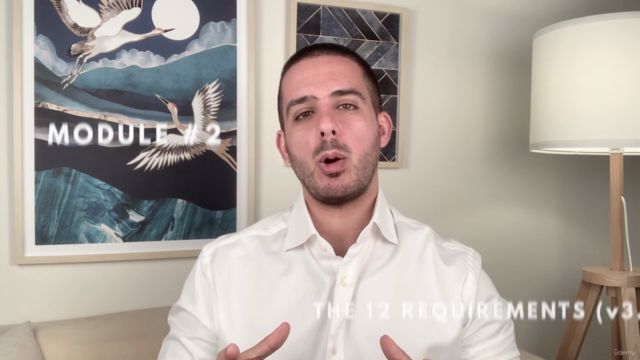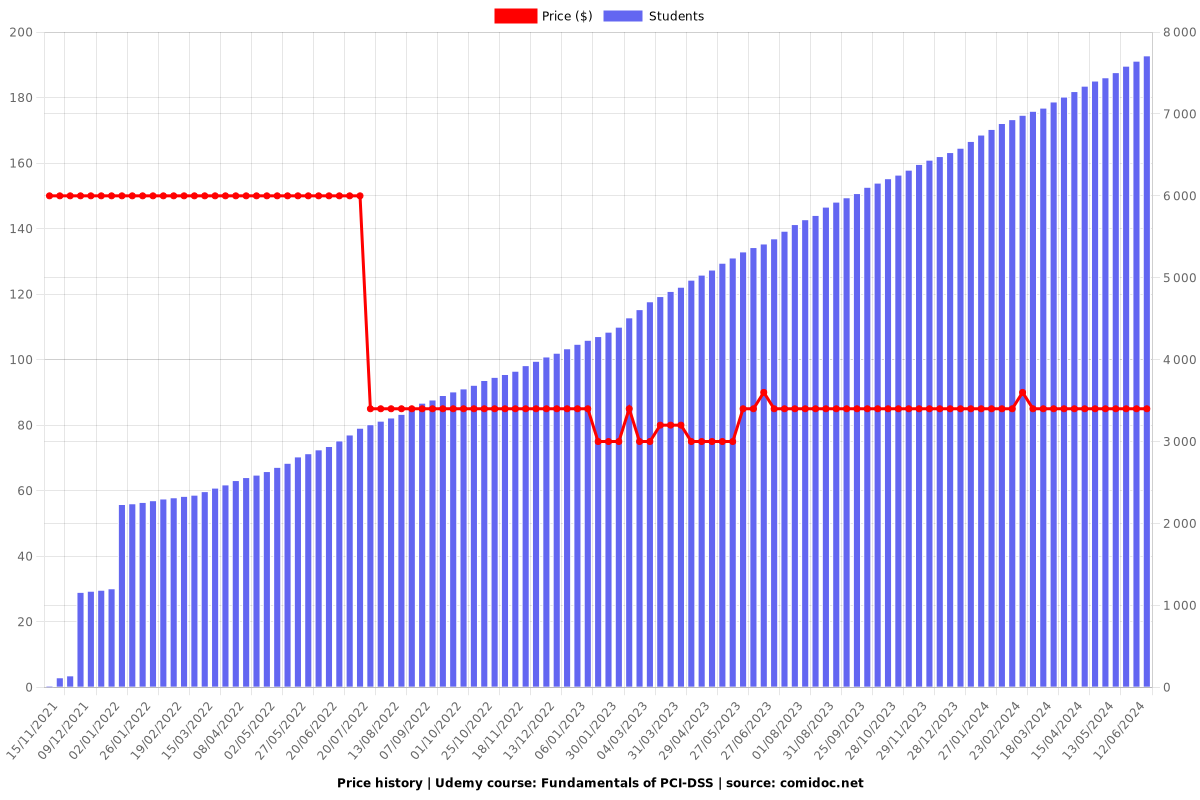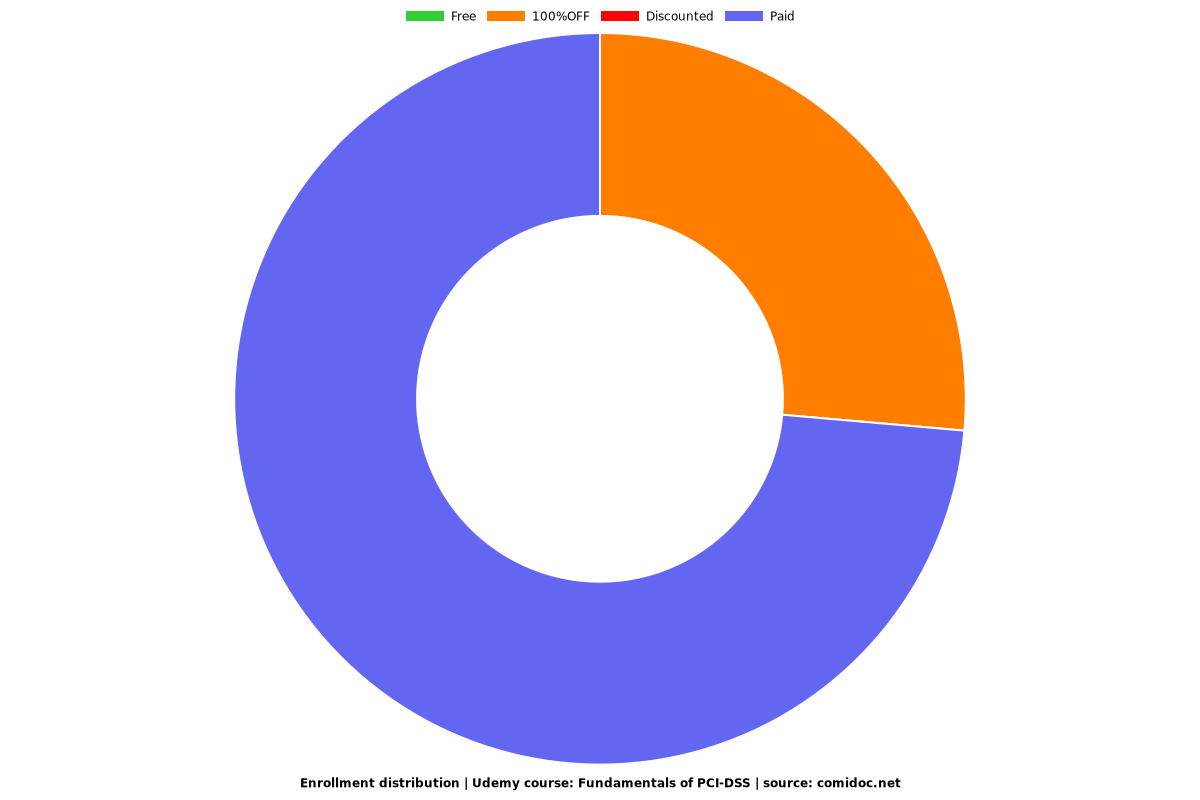Title
Fundamentals of PCI-DSS v4.0.0
Learn everything about the Payment Card Industry Data Security Standards, including assessment and the 12 requirements.

What you will learn
You'll learn about the terminology essential to the PCI-DSS, such as CDE, CHD, SAD, PANs, SAQs, ROCs, QSAs, as well as other payment industry terms
You'll learn about the history of the PCI-DSS and its major revisions
You'll learn about how the assessment process works, with ROCs and SAQs, and a clarification of the 8 types of SAQs
You'll learn everything about Requirement 1, involving having a firewall configuration to isolate your card data, network documentation and more
You'll learn everything about Requirement 2, including changing vendor defaults, isolating server functionality and securing vulnerabilities in devices
You'll learn everything about Requirement 3 in terms of securing stored data, including encryption protocols, key lifecycle, key management and more
You'll learn everything about Requirement 4, protecting data in transit, including masking plaintext PANs and using strong encryption protocols such as WPA/WPA2
You'll learn everything about Requirement 5, in terms of preventing malware through an antivirus solution that is frequently updated and frequently runs scans
You'll learn everything about Requirement 6, in terms of developing securely, doing regular vulnerability assessment and patching
You'll learn everything about Requirement 7, in terms of limiting access to card data by "need-to-know", minimising who accesses it formally
You'll learn everything about Requirement 8, in terms of identifying access through unique user IDs, strong authentication and MFA, password practices and more
You'll learn everything about Requirement 9, in terms of physical security, visitor identification/authorisation, as well as media storage/transport/destruction
You'll learn everything about Requirement 10, in terms of having a logging solution, logging specific required events, specific data points, and log integrity
You'll learn everything about Requirement 11, in terms of doing regular AP (authorised + rogue) and IP audits, vulnerability testing, pentesting, etc
You'll learn everything about Requirement 12, in terms of having a company-wide InfoSec policy, including employee screening, third-party screening, etc
Why take this course?
🔒 Master PCI-DSS: A Comprehensive Journey Through Data Security Standards
🚀 Welcome to Your Definitive Guide to Payment Card Industry Data Security Standards (PCI-DSS)!
Are you concerned about the increasing rate of payment card fraud? As a business or individual dealing with card data, understanding and implementing the PCI-DSS is crucial for safeguarding your transactions. This course is your ticket to mastering these critical standards.
🎓 Course Overview:
In this in-depth course, you'll embark on a journey through all 12 requirements of PCI-DSS. Each requirement will be broken down into digestible lessons, ensuring you comprehend the underlying principles and can apply them effectively. From protecting cardholder data to maintaining a vulnerability management program—you'll cover it all!
🔍 What You'll Learn:
- Protect Cardholder Data (Requirement 1-4): Learn how to encrypt, hide, and protect sensitive information both at rest and in transit.
- Maintain Secure Systems (Requirement 5-6): Discover how to develop secure code and prevent malware with robust antivirus solutions.
- Ensure Physical Security of Cardholder Data (Requirement 7-8): Understand the importance of limiting physical access and ensuring that every action is tied to a unique user.
- Monitor Networks for Vulnerabilities (Requirement 9-10): Get insights into regular monitoring, logging, and testing to identify and mitigate potential threats.
- Implement a Comprehensive InfoSec Policy (Requirement 12): Learn about the policies and procedures that define roles, responsibilities, and security measures within an organization.
🛡️ Key Highlights:
- A step-by-step breakdown of all 12 PCI-DSS requirements with real-world applications.
- Strategies for integrating security into your organizational culture.
- Practical tips for conducting vulnerability assessments and penetration tests.
- Guidance on choosing the right third-party vendors.
- Best practices for maintaining a secure environment before and after a compromise.
💰 Risk-Free Learning Experience:
- Money-Back Guarantee: Enroll with confidence knowing you have a full 30 days to experience the course risk-free.
- Preview Videos: Take advantage of free preview videos to ensure this course aligns with your learning goals and style.
📆 Why Wait?
Don't let payment card fraud compromise your business or personal transactions. With the knowledge gained from this comprehensive course, you'll be well-equipped to protect sensitive data and maintain compliance with PCI-DSS.
Join hundreds of satisfied learners who have taken their understanding of payment security to the next level. Enroll now and secure your role as a PCI-DSS expert!
👉 Enroll Today and Transform Your Approach to Payment Security Tomorrow! 🌟
Screenshots




Our review
Overview of the Course: Global Rating - 4.56
The online course on PCI-DSS has received an overwhelmingly positive response from recent reviewers, with a global rating of 4.56. The majority of users found the course to be exceptionally informative and well-structured for understanding the Payment Card Industry Data Security Standard (PCI-DSS).
Pros:
- Comprehensive Understanding: The course effectively simplifies the PCI-DSS framework, making it accessible for learners of all levels.
- Repetition for Memory Aid: The repetition of information throughout the course is highlighted as a beneficial technique for reinforcing key concepts.
- Clear and Simplified Explanations: Reviewers appreciate the clear explanations provided for each part, with summaries that help reinforce understanding.
- Practical Application: The course content has been praised for its practical examples and scenarios, which are deemed essential for real-world application.
- Supportive of Certification Preparation: Some users have reported success in certification exams like the QSA (Qualified Security Assessor) as a direct result of taking this course.
- Well-Curated Content: The course is considered well-paced and appropriate for beginners, with content that covers both basics and details effectively.
- Recap Videos: The recap videos at the end of modules are appreciated for their ability to refresh a learner's memory after some time.
- Relevant Additional Resources: The accompanying resources are considered valuable additions to the course material.
- Informative and Educational: The course is described as insightful and detailed, providing all the knowledge needed for understanding PCI-DSS.
- Easy to Follow: The presentation of the course is regarded as clear, interesting, and easy to follow.
Cons:
- Redundancy: Some users felt that the repetition of the same information multiple times was redundant and a waste of time.
- Language and Pacing Issues: A few reviewers criticized the speaker's pacing, which they found too slow and monotonous, or overly verbose with unnecessary pauses, resembling explanations for a younger audience.
- Irrelevant Content: There were mentions of certain sections being unrelated to the core topic and suggested to be offered as separate additional courses.
- Distraction from Presentation Style: The speaker's cadence and delivery style distracted some users, who found it either too slow or childlike in approach.
- Training Section Feedback: Some users would prefer to have a specific training section (6 about Pitching Technical Projects) excluded as it was considered not strictly relevant to the core topic of PCI-DSS.
- Technical Glitches: There were occasional reports of technical issues with the course material or delivery platform.
Recommendations for Improvement:
- Update Content: Some users requested an update to the course content to reflect the latest version (4.0).
- Adjust Presentation Style: To address pacing and presentation style issues, adjustments may be needed to ensure the material is engaging and not overly slow or simplistic.
- Consider Optional Modules: For sections of the training that are less central to the PCI-DSS focus, consider offering them as optional modules instead.
- Improve Technical Support: Ensure that any technical issues are promptly addressed to enhance user experience.
Conclusion:
The course is highly recommended for those studying cybersecurity or specifically looking to understand PCI-DSS. The positive feedback far outweighs the negative, with most users finding the course to be valuable and educational. With a few adjustments to address the cons and recommendations for improvement, this course has the potential to remain a leading resource in understanding and implementing PCI-DSS compliance standards.
Charts
Price

Rating

Enrollment distribution

Coupons
| Submit by | Date | Coupon Code | Discount | Emitted/Used | Status |
|---|---|---|---|---|---|
| - | 16/11/2021 | B7E3130EDE5C278C5112 | 100% OFF | 100/99 | expired |
| - | 02/12/2021 | 358E3CC361371B690795 | 100% OFF | 1000/901 | expired |
| - | 05/01/2022 | 2652BA5C8CA73A0D746D | 100% OFF | 1000/964 | expired |
| - | 21/10/2024 | F310728F99D19D8D4829 | 100% OFF | 1000/948 | expired |